Let the questions begin 😉 Mine are on the Meconopsis, long grass, a plant ID, a Buddleja suggestion and New Zealand flatworms. Can you help here? I’d like to welcome answers via comments on this post or by email. Thank-you to anyone that gets back to me 🙂
Before I begin I’d like to say a huge welcome and thanks to any bloggers that have taken up the challenge of joining me with a set of questions at such short notice. I have to say I’ve found considering mine more fun than I expected and I hope you have too 😀
Question 1: Why is my Meconopsis not flowering?
May 2011 was when the yellow Meconopsis shown in the montage above flowered. I know Meconopsis can take a few years to flower. However, I’m still waiting for the other two young plants (exact same size) that were bought at the same time back in 2008. I don’t know what is going on here – does anyone have success at growing these plants?
The image above was taken this morning, unlike the Blue varieties I have, these plants stay in leaf all year round and have faced some pretty cold winters. Sorry I don’t know the variety. The one plant that did flower grew tall and had clusters of flowers down the stem which opened from the top. Oh yes… the yellow flowers have never been seen since. I do think that plant possibly died. I ahve heard of plants taking years to flower and then dying – but not Meconopsis.
Question 2: Any variety suggestion for a grass mound?
Having built two small grass mounds on either side of my arbour path I’m disappointed with the way they are looking during the growing season. I wondered if anyone has a grass mound in their garden that stays short enough (without clipping) so that clover and other small wildflowers could successfully grow with it. I know grass is a greedy plant and can choke out other plants.
July 2010 is when the newly sown grass seed (general mix suitable for shade) shown above thickened up and the Californian poppy seeds that I added came in to flower. You can roughly see my vision here. Once again, disappointingly the next year I had no flowers – well perhaps just one! I don’t want to start again with this unless I have to as it took ages to get the shape which isn’t shown to clearly above.
Question 3: Does anyone know what this plant is?
My guess is that the plant above arrived in my garden (it began as a single plant) via birds. I definitely didn’t buy it and initially I considered pulling it out thinking it could be a weed. Then when the tall stems with tiny trumpet flowers running up them grew from a neat clump of leaves I considered even if it were a weed I quite liked. However, I doubt it is a weed as it would have spread much quicker round my garden than it has. I’m guessing there has to be a number of bloggers who might know what this is?
Question 4: Has anyone tried the Buddleja Buzz Series?
From memory the Buddleja above is a Davidii which was growing in my sunny open front garden. Space is limited here due to the parking of cars and after a revamp to planting in my main triangular border I removed this plant a few years ago.
Sedums in this border are a magnet to butterflies and in the few days after my Dad died last September I spotted a new species to my garden (the Comma). As time has past, I’ve decided I want to attract even more species of butterflies to this area – now in memory of my Dad 🙂
After seeing the Buzz Series mentioned at RHS Hampton Court as a good (pretty small) Buddleja for butterflies I was wondering if anyone has tried growing it and how it has performed. I’m guessing this is a new introduction. I was thinking of the magenta one and growing a couple together – it’s height I don’t have space for.
Question 5: Does anyone have New Zealand Flatworms in their garden or allotments?
For those that don’t know about this earthworm hunter and destroyer, it covers the earthworm then excretes an enzyme that enables it to absorb it – basically it feeds on them in a horrible way. If you ever find a New Zealand Flatworm you should destroy it before it destroys your earthworm population! This can easy be done by lifting the flatworm and putting it in a jar of salted water. I might suggest a jam jar with lid is used. Within a couple of days the poisonous enzyme gets the flatworm itself and the worm goes milky (and smelly too if you were to open the jar).
Sorry, I hope you haven’t been having breakfast of lunch when you’ve been reading this. My garden is living proof that a garden can survive with a very, very minimal population of earthworms so don’t worry if you ever see one in your garden or allotment – you should be aware they could be around though.
Oops… on that unpleasant note I’ll ring the bell and say my Questions have come to an end – I hear shivers of relief! I’m looking forward to seeing what other Bloggers’ Questions might be around today – check out the comments for other Blog links. It’s probably safe to say they are likely to be much more pleasant questions than my last one… enjoy the day 🙂
This post was published by Shirley for shirls gardenwatch in February 2013.
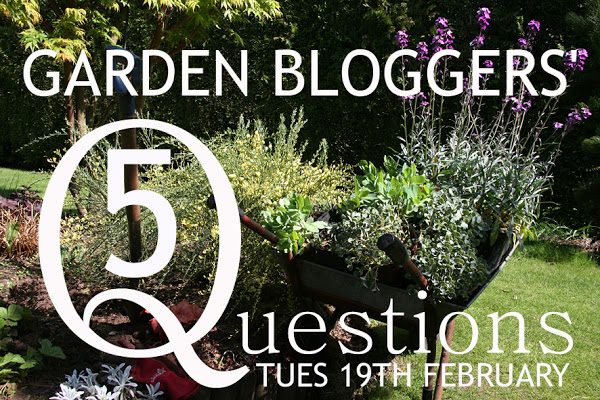
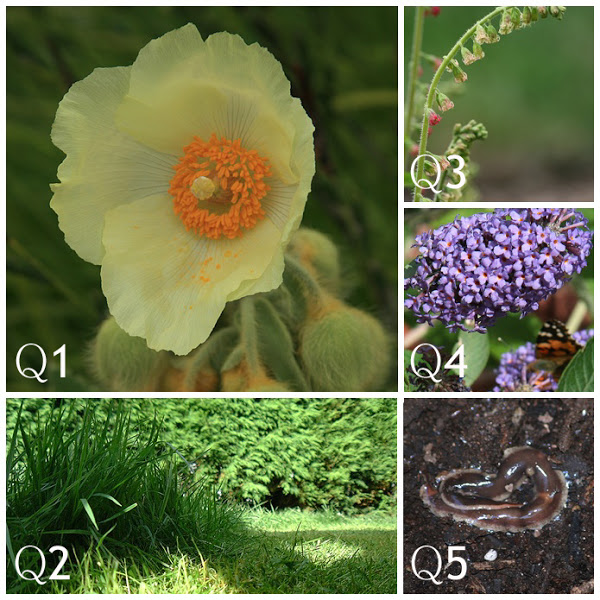
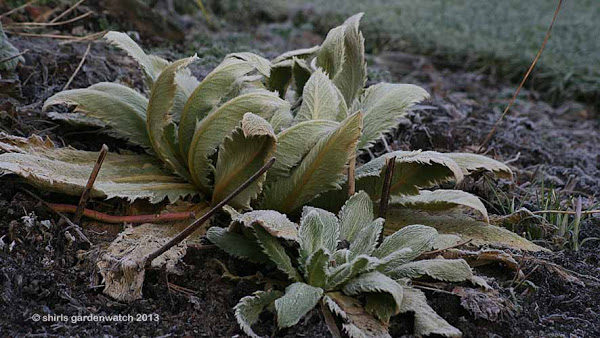

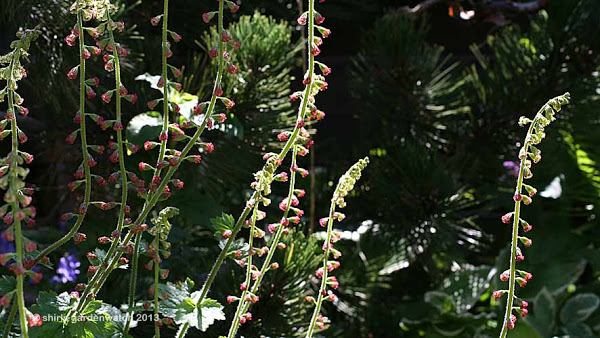
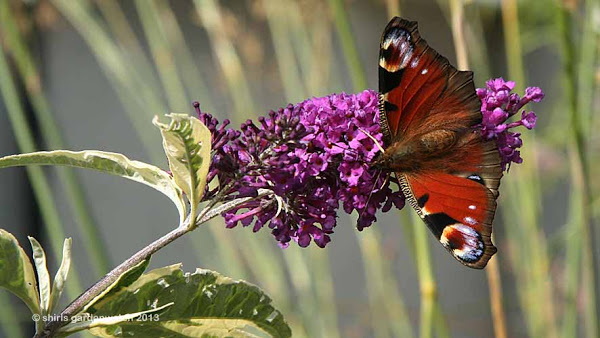
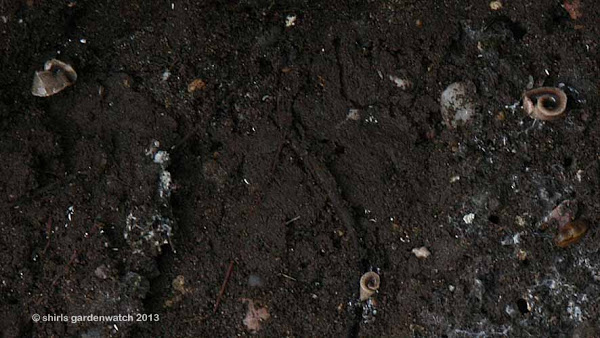
Hi Shirl
I wont be joining in with questions this time as it was too short notice for me but here are some possible answers
1 – it looks like Meconopsis nepalense which I believe is quite difficult. Maybe knowing the name could help you find out more. If you look on the Scottish Rock Garden Society forums you might find something as it is an alpine.
3? – mystery plant looks like abit like a Heucherella which I think is a cross between a Heuchera and a Tierella.
Not sure how helpful that is!!!!!
Hi Shirl
A bit of research has thrown up this link which might help with your meconopsis. It seems it needs very rich and moist soil meconopsis.org/miscdocs/TomPollard.pdft
Thanks for your answer suggestions, Helen 🙂
No bother at all 🙂 I completely appreciate I didn’t give a lot of time on this and it’s not like I had a post ready to publish myself either. I just wanted to fit in a couple of posts in February and the days ran away from me 🙂
Thanks for the ID for Question 1 🙂 Checking out your links it looks like that’s exactly the variety that my yellow one was. Scanning through the link you found it seems this variety is monocarpic, dying after flowering. I hadn’t realised that at all. I still don’t understand why the other two plants haven’t flowered yet when in exactly the same soil and light conditions as the one that did and the other blue ones that are quite happy. Maybe as you say they are just hard to grow. You can see there is a smaller plant to the front of the larger one and I’m wondering perhaps that this is the yellow one that has seeded itself. Time will tell – I’m ever optimistic. I’ll keep seeds next time (should there be any more flowers) and post some down to you if you want to give it a try 🙂
Sorry Helen, meant to add… I really am curious… do you see New Zealand Flatworms in your garden or when you had your allotment? I have wondered if the spread across the UK has slowed down at all. A Crop Research Institute up my way was doing research and logging sightings for a few years but lost funding the last I had heard 🙁
Here’s a link to another blogger with five more question over at Veg Plotting. Thanks for joining in 😀
Sorry Helen, where’s my head today… half asleep after working on this post too late last night/early this morning :-0
Thanks also for your ID suggestion for Question 3. I have a few Heucheras in my garden and have been fancying adding Tierallas. I never considered this as a possible ID. Interesting … I’ll email/tweet Heucheraholics. Thanks 🙂
Have you tried growing yellow rattle on your grass bank as it is supposed to 'parasitise' grass roots and weaken the grass.
Thanks for your answer suggestion for Question 2, Sue 🙂
No, I haven’t tried yellow rattle. I’m not really a yellow flower fan but in this instance it might be worth making an exception and giving it a go. The ornamental grass Bowles’ Golden is edging my new wildlife pond (build still in progress) nearby so that might work. I'd never heard of a plant 'living a semi-parasitic life by feeding off the nutrients in the roots of nearby grasses'. I'm enjoying learning more today 😀
Have you ever seen New Zealand Flatworms in your garden or allotment?
Shirl
I have never seen, nor I hope will ever see, the flatworms
I have some plants that look like your no 3 and they came from some seeds of a seed distrubtion scheme which I think were mislabelled but they are good doers and fillers. Expect it to self-seed all over the place though.
I dont think all meconopsis poppies are monocarpic but many varieties are so I suppose it depends on what you have – all rather confusing I think
Hello again Helen, delighted to hear you haven’t seen Flatworms with you 🙂
Yes, number 3 has self-seeded gently around an area of my garden. It hasn’t got everywhere so I don’t see it as a problem plant. I forget to say when it was shown above in flower – May 5th.
Yes you’re right on the meconopsis. I have Blue Poppies that I’ve had for years – although their foliage dies completely away (I added small canes as location markers in the early days) so maybe that is a clue – if a meconopsis keeps its leaves all year then its monocarpic? Just a thought 🙂
Hi Shiirl
No 3 is Tellima grandiflora. Yes it self seeds freely but is very useful in a shady area, insects love the flowers which are pleasantly scented. I think it makes a nice ground cover in places where not. Much else will grow
And I've never seen a flatworm.
Brilliant Celia!! You help me out with an ID once again 🙂
That’s exactly what my plant is and loving the partial shade in my back garden! I must check it out for scent when it flowers this year. Come to think of it I’m sure I’ve seen bees show interest in it.
Now I know it’s not a weed I’ll lift some of the seedlings and spread it to other shady areas. It might like round my pond too!
Brilliant news on the Flatworm too! I’m stuffed up here when the ‘The first knowledge of the existence of the New Zealand flatworm in Scotland was from the Edinburgh Botanic Gardens in the 1950s.’
I gave the first recorded sighting in my area and some time later asked the Crop Institute research guy about another I discovered thinking it was different type from the usual ones I had found/collected. A bit of excitement there with us being asked to put flatworm specimen in a dark photo film container with some alcohol and someone arriving at my door at midnight (after an event in Edinburgh) to collect it! Turned out it was just the usual type but he could see why I thought it was different. Haha.. the joys of being a gardener 😉
I like the idea of this meme. Is this a one off Shirley?
Celia beat me to the id for Tellima. My understanding of monocarpic is that once the plant flowers it completely dies. Made that mistake a few times with the blue one. The Meconopsis website is full of good information.
I'm presently waiting on a little beauty M. x cookei Old Rose to flower for me this year . Re the buddlja the only thing I know is that when ordering mail order, especially those offers in the press, the specimens are tiny. Can't you keep in control of size by pruning. There are some gorgeous Buddlja out there especially if you can give the the right conditions.
Thanks for another confirmation to answer for question 3, Angie 🙂
Yes, I believe you are right on the monocarpic. My Blue poppies flowered for a number of years before I lost a couple. I still have one that has to be around 10 years old – this variety doesn’t set seed so I guess that is why it has lasted so long.
My query is still that three plants, bought at the same place, same size and planted in the same border with the same soil conditions and light grew to the same size and only one flowered. I was thrilled at the time!! I am sick that I was careless with my seed collecting and didn’t store them correctly. I still have the other two original plants and a young offspring now too. I am being uncharacteristically patient with them and allowing them to rent space in my border 😉 Thanks, I know the websites offer great advice and I was probably being too optimistic hoping that another blogger already growing meconopsis would stumble on this post and had personal experience here.
Re x cookei – what an absolute beauty this is!! I had this one – see previous post with images of x cookie in flower. I can hear you swooning from here. However, just in case you didn’t read comments Rosie and Leavesnbloom left one suggesting I perhaps shouldn’t have let it flower the first time. Perhaps she was right as I never saw this plant again. Perhaps you want to do some research for yours. Sorry to spoil your expectation for first flowers. If your plant is mature then it’s probably okay. Check this out 🙂
Yes, I hear you on mail order plants – that’s why I was asking if anyone was growing a buzz series. I’d like to know if it gets as many blooms as growers suggest. I’d try to get to a nursery for a more established plant. I really haven’t got the space in height or width (left) in my sunnier front garden and that is why I was considering growing a low clump. Thanks for your suggestions though 🙂
Finally, I was trying to keep this post idea slightly open to come back to again another time (probably winter months again). Don’t really want to start a regular meme as there are so many running now for bloggers to pick and choose and I’m aware of reducing blogging hours in the months ahead. Thanks, I do like this idea too and I never say never when it comes to blog posting 😉
ewee to the flat worms, I haven't spotted those here.
I love tellima – really good in woodland situations where not musch else will survive and has a delightful scent.
I have put my post up – although I only have one question! So lovely to get your thoughtful email
K
xx
What a lovely surprise to have you join me on this! I didn’t expect you’d manage and what a great question to put up too. What a contrast to your back garden. If I come across images that might be of interest in my garden /visit/show photo searches I’ll mail you them 😀
I’m delighted that with your rainfall you don’t see flatworms as they like damp conditions!
I really am delighted to have name for this plant that arrived in my garden all by itself and has made it home. I’ll treasure it now instead of squinting at it wondering who this uninvited garden visitor is. It is welcome to stay 😀
Shirley, thanks for pointing me in the direction of your Meconopsis blog. Swoon – I'm afraid is a bit of an understatement!
I see yours was flowering in August. I was under the impression that they are late spring flowerers! We shall see how they go. I'm actually going to the nursery where I bought these on Saturday – I want to buy a couple more to try in an area that is a bit shaded. I'll ask for some advice.
Have you tried giving yours a feed? Maybe they just need a bit of a boost!
Celia has taken the words out of my mouth Shirl re Q3 but I know it as tellima odorata. Seeds quite freely but never a nuisance. No flatworms in the garden I!m glad to report 🙂
Yikes…those flatworms sound awful! Not sure about the Meconopsis…except that they are notoriously difficult…good luck!
Hi Shirl, just found your site, I must say its great.
Buddleia buzz didnt do well at all for me, my garden is heavy clay.My allotment is lovely loam…it used to be a river bed….and because you like the birds…it will be swallow time soon. I cant wait.
Hello everyone, thanks for all your comments 🙂
Angie, ah, I don’t think my plant should have flowered in August. I hope you got good advice at the nursery. I’ve never fed my meconopsis – I should look in to that – thanks 😀
Anna, excellent, great to hear about it not being a nuisance. It hasn’t been so far but I considered things might change. Good news on that and the flatworm!
Scott, great to hear no more flatworms! I always hoped that a predator would come along and sort them out. Haha… I don’t usually entertain notoriously difficult plants 😉
Sorrelsmum, thanks for popping by especially with a comment on the b buzz. Mm… you make a good point on the soil. I should look into that first. I’m got nice loam here. Thanks 😀
Here’s a link to another blogger… do you have an answer to one question from Karen over at An Aritist's Garden?
I completely missed this, Shirl, sorry – am spending most of my computing time on Rightmove at the moment! I would have joined in if I'd seen it sooner, so I'd love to have another questions date (especially if it's after I've got a new garden!).
I got 3 Buddleia Buzzes from T&M last year, my Mum had one, and I am growing the others in pots. They were really tiny when they arrived, though I think you can now get bigger ones in GCs. They seem to be very slow-growing, and they more or less die down over the winter, so you can keep them trimmed to size by cutting them back in spring. Keeping them in pots solves the soil question.
Mine (and Mum's) haven't done much in the way of flowering yet (one or two flowers each), but they were so small I wouldn't really expect them to. They didn't seem to attract butterflies last year, but that may change as they get bigger and get more flowers. They did attract snails! – so if you get very small ones too you'll need to protect them until they've grown a bit.